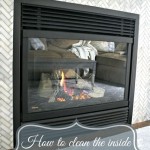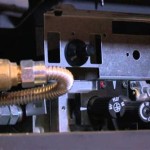Fireplace Makeovers: Dramatic Transformations Before and After
Fireplaces often serve as the focal point of a living space, acting as a gathering place and a source of warmth and ambiance. However, outdated or poorly maintained fireplaces can detract from the overall aesthetic of a room. A fireplace makeover can dramatically improve the appearance and value of a home. These renovations range from simple cosmetic updates to comprehensive structural overhauls. This article will examine various fireplace makeover projects, highlighting the before-and-after transformations and discussing the factors that contribute to successful outcomes.
The concept of a fireplace makeover encompasses a wide array of design and construction techniques. It may involve replacing outdated materials, altering the style to align with current trends, improving energy efficiency, or simply enhancing the existing structure's visual appeal. The scope of the project is determined by factors such as budget, desired aesthetic, and the condition of the existing fireplace.
Updating the Fireplace Surround
One of the most impactful aspects of a fireplace makeover involves updating the surround. The surround refers to the non-combustible materials that frame the fireplace opening, typically consisting of a mantel, hearth, and facing. Outdated surrounds made of materials like dated brick or dark wood can be replaced with more contemporary options such as natural stone, tile, or sleek modern wood paneling. The selection of new materials can significantly alter the style of the fireplace, transitioning from traditional to modern, rustic to elegant, depending on the desired outcome.
Consider a fireplace with a dated red brick surround. The "before" picture reveals a fireplace that appears heavy and visually dominant, potentially clashing with the overall design of the room. A makeover could involve cladding the brick with a light-colored manufactured stone veneer. The "after" picture would then showcase a lighter, more modern fireplace that blends seamlessly with the room's decor. Often, adding or replacing the mantel with a more substantial piece of wood or a minimalist floating shelf can enhance the visual impact even further. The color and texture of the chosen stone veneer can also contribute to the overall style. For example, a grey ledgestone veneer can create a rustic, yet refined look, while a smooth, light-colored tile can lend itself to a more contemporary aesthetic.
The hearth, the non-combustible area in front of the firebox, is another crucial element of the surround. A small, raised brick hearth can be replaced with a large, level hearth made of slate or concrete. This change can not only update the look of the fireplace but also improve its functionality by providing a more substantial surface for placing fireplace tools or decorative items. The hearth can even be extended to create a more prominent architectural feature.
Paint is another cost-effective method for updating the fireplace surround. Painting brick, for example, can drastically change its appearance. Applying a coat of white or light gray paint can instantly brighten a room and create a more modern aesthetic. However, it is important to use heat-resistant paint specifically designed for fireplaces to ensure durability and prevent discoloration over time. A "before" image might show a dark and dated brick fireplace. The "after"image could show the same brick, painted a clean, crisp white, transforming the space to be more bright and inviting.
Converting to a Different Fuel Source
Another significant fireplace makeover option involves converting the fuel source. Traditional wood-burning fireplaces, while aesthetically pleasing, can be inefficient and produce significant amounts of smoke and pollutants. Converting to a gas or electric fireplace offers several advantages, including improved energy efficiency, reduced emissions, and increased convenience. The visual impact can be dramatic, and the functional benefits often outweigh the initial investment.
Consider a homeowner who decides to convert their existing wood-burning fireplace to a gas fireplace. The "before" picture might show a standard wood-burning insert with a traditional damper system. The "after" picture would feature a sleek, modern gas insert with realistic-looking ceramic logs. The conversion process typically involves installing a gas line to the fireplace and replacing the wood-burning insert with a gas-burning unit. Many gas inserts include features such as remote control operation, adjustable flame height, and programmable thermostats, offering greater control and convenience. Moreover, gas fireplaces are often more energy-efficient than wood-burning fireplaces, reducing heating costs and environmental impact.
Electric fireplaces represent another alternative. These units are relatively easy to install, requiring only a standard electrical outlet. Electric fireplaces offer a range of styles and features, including realistic flame effects, adjustable heat settings, and remote control operation. While they do not produce real flames, many modern electric fireplaces offer incredibly realistic simulations that can enhance the ambiance of a room. Converting to an electric fireplace can be a particularly attractive option for homeowners who want to update their fireplace without the expense or hassle of installing a gas line or dealing with wood-burning debris.
Ethanol fireplaces are another option to consider. These fireplaces burn liquid ethanol fuel, producing a clean-burning flame without the need for a chimney or venting system. Ethanol fireplaces are available in a variety of styles, from tabletop models to wall-mounted units, and can be a stylish and eco-friendly alternative to traditional fireplaces. They offer a modern aesthetic, often featuring minimalist designs, and are easy to install and operate.
Structural Modifications and Enhancements
In some cases, a fireplace makeover may involve structural modifications to improve its functionality or aesthetic appeal. This could include resizing the firebox, adding built-in shelving, or extending the fireplace surround to create a more prominent architectural feature. Such projects require careful planning and execution to ensure structural integrity and compliance with local building codes.
Imagine a fireplace that is disproportionately small for the size of the room. A structural makeover could involve expanding the firebox and surround to create a more visually balanced focal point. The "before" picture would show a fireplace that appears dwarfed by the surrounding space. The "after" image would reveal a larger, more imposing fireplace that commands attention and enhances the room's overall design. Expanding the fireplace may involve removing existing walls and reframing the area to accommodate the larger structure. This process requires the expertise of a qualified contractor to ensure that the building's structural integrity is maintained.
Adding built-in shelving or cabinetry around the fireplace can also enhance its functionality and aesthetic appeal. Built-ins can provide additional storage space for books, media equipment, or decorative items. They can also help to integrate the fireplace into the overall design of the room, creating a cohesive and harmonious look. The "before" picture might show a plain fireplace wall. The "after" picture would feature a fireplace surrounded by custom-built shelving, creating a stylish and functional storage solution. Built-ins can be designed to complement the style of the fireplace and can be customized to meet the specific needs of the homeowner.
Another structural modification could involve adding a new chimney cap or chase cover. These components protect the chimney from rain, snow, and debris, preventing damage and improving the fireplace's overall efficiency. A damaged or outdated chimney cap can detract from the appearance of the fireplace. Replacing it with a new, stylish cap can enhance its visual appeal while also providing essential protection. The "before" picture might show a rusted or damaged chimney cap. The "after" picture would show a new, copper chimney cap that adds a touch of elegance to the exterior of the home.
Furthermore, the design of the firebox itself can be altered. Modern fireplace inserts often feature larger glass doors for a better view of the flames. Some incorporate elements such as decorative firebacks or ceramic logs designed specifically to enhance the visual warmth. These modifications improve the fireplace's aesthetic appeal and increase its functionality in providing heat and ambiance.
The process of a fireplace makeover, regardless of the scope, often involves a significant amount of demolition and reconstruction. Careful planning and budgeting are essential to ensure that the project stays on track and within budget. Engaging a qualified contractor with experience in fireplace renovations is crucial to ensure that the work is done safely and according to building codes. Before embarking on a fireplace makeover, homeowners should research different design options, gather inspiration from magazines and online resources, and consult with professionals to create a plan that meets their needs and aesthetic preferences. The "before" and "after" results can be remarkably different, transforming a dull and outdated fireplace into a stunning focal point that enhances the beauty and value of the home.

Fireplace Makeover Before And After Sweet Tooth Life

10 Fireplace Makeover Ideas Before And After Regency

Modern Farmhouse Fireplace Makeover Before After Fueling Mamahood

47 Stellar Diy Fireplace Remodel Makeover Ideas Remodelaholic
5 Amazing Inexpensive Easy Fireplace Remodel Transformations Designed

Modern Fireplace Makeover Momma From Scratch

Fireplace Makeover Lydi Out Loud

Diy Before And After Fireplace Remodel Idea Brick Makeover

Fireplace Before After Part 2 Aht Interiors

Fireplace Makeover Before After The Inspired Room
Related Posts








